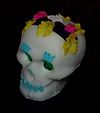
Calavera
Encyclopedia


Spanish language
Spanish , also known as Castilian , is a Romance language in the Ibero-Romance group that evolved from several languages and dialects in central-northern Iberia around the 9th century and gradually spread with the expansion of the Kingdom of Castile into central and southern Iberia during the...
for "skull
Human skull
The human skull is a bony structure, skeleton, that is in the human head and which supports the structures of the face and forms a cavity for the brain.In humans, the adult skull is normally made up of 22 bones...
", can refer to a number of cultural phenomena associated with the Mexican
Mexico
The United Mexican States , commonly known as Mexico , is a federal constitutional republic in North America. It is bordered on the north by the United States; on the south and west by the Pacific Ocean; on the southeast by Guatemala, Belize, and the Caribbean Sea; and on the east by the Gulf of...
celebration of the Day of the Dead
Day of the Dead
Day of the Dead is a Mexican holiday celebrated throughout Mexico and around the world in many cultures. The holiday focuses on gatherings of family and friends to pray for and remember friends and family members who have died. It is particularly celebrated in Mexico, where it attains the quality...
and the Roman Catholic holiday All Souls Day
All Souls Day
All Souls' Day commemorates the faithful departed. In Western Christianity, this day is observed principally in the Catholic Church, although some churches of Anglican Communion and the Old Catholic Churches also celebrate it. The Eastern Orthodox Church observes several All Souls' Days during the...
.
- calaveras de azúcar ("sugarSugarSugar is a class of edible crystalline carbohydrates, mainly sucrose, lactose, and fructose, characterized by a sweet flavor.Sucrose in its refined form primarily comes from sugar cane and sugar beet...
skulls") are used to adorn altars and can be eaten. - calaveras literarias are poems, written for the Day of the Dead but intended to humorously criticize the living.
- calavera can refer to any artistic representations of skulls, such as the lithographs of José Guadalupe PosadaJosé Guadalupe PosadaJose Guadalupe Posada: was a Mexican cartoonist illustrator and artist whose work has influenced many Latin American artists and cartoonists because of its satirical acuteness and political engagement....
. - Cervecería Calavera is also the name of a newly started craft brewery in Mexico City.
Sugar Skull Tradition - Sugar art was brought to the New World by Italian missionaries in the 17th century. The first Church mention of sugar art was from Palermo at Easter time when little sugar lambs and angels were made to adorn the side altars in the Catholic Church.
Mexico, abundant in sugar production and lacking money to buy fancy imported European church decorations at the time, learned quickly from the friars how to make sugar art for their religious festivals. Clay molded sugar figures of angels, sheep and sugar skulls go back to the Colonial Period 18th century. Sugar skulls represented a departed soul, had the name written on the forehead and was placed on the home ofrenda or gravestone to honor the return of a particular spirit. Sugar skull art reflects the folk art style of big happy smiles, colorful icing and sparkly tin and glittery adornments. Common ingredients for making sugar skulls include powdered sugar, egg white, corn syrup, vanilla, and corn starch. Typically, sugar skulls need to dry overnight or for several hours. Sugar skulls are labor intensive and made in very small batches in the homes of sugar skull makers. However, these artisans are disappearing as fabricated and imported candy skulls take their place.

